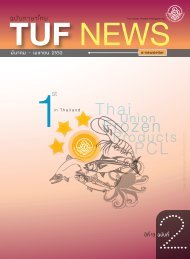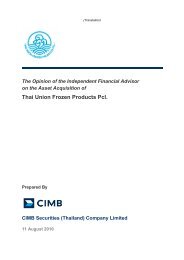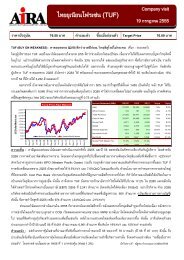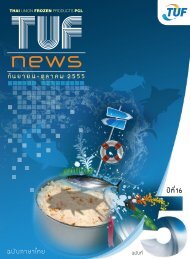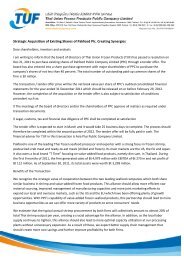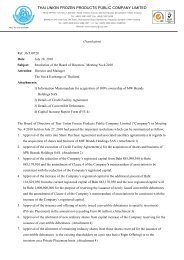Thai Union Frozen Products Public Company ... - Investor Relations
Thai Union Frozen Products Public Company ... - Investor Relations
Thai Union Frozen Products Public Company ... - Investor Relations
You also want an ePaper? Increase the reach of your titles
YUMPU automatically turns print PDFs into web optimized ePapers that Google loves.
N e w s f o r I n v e s t o r sVanuatu, South Korea, the Maldives, and Japan.<strong>Thai</strong>land’s imports of frozen tuna have fluctuated,depending on tuna prices and world supply. In2006, <strong>Thai</strong>land imported 783,443 tonnes offrozen tuna, a 6% increase from the previousyear. However, due to high tuna prices during theJanuary-August 2007, the import volumedecreased 13% year-on-year to 473,884 tonnes.Production of canned tuna in <strong>Thai</strong>land grewat 8.5% per annum during 1999-2005. This is animpressive growth, considering that globalproduction grew by only 1.6% per annum duringthe same period. Data from the Office ofIndustrial Economics shows that total productionof canned tuna in <strong>Thai</strong>land was 435,857 tonnes in2006, with 95.49% of production exported.However, canned tuna production decreased to247,397 tonnes in the first eight months of 2007,or dropped by 15.5% year-on-year, due to theincrease in tuna price.In 2006, <strong>Thai</strong>land exported 416,203 tonnes ofcanned tuna, a 12.9% rise from 2005. The US isthe biggest importer of <strong>Thai</strong> canned tuna,followed by Australia, Canada, and Japan. Inaddition, canned tuna from <strong>Thai</strong>land also claimsthe biggest market share of total US canned tunaimports, with a 37.6% share in 2006. Although<strong>Thai</strong>land’s canned tuna production droppedduring January-August 2007, <strong>Thai</strong>land’s cannedtuna export grew by 3.3% from the same periodin 2006 to 280,243 tonnes.Tonnes450,000400,000350,000300,000250,000200,000150,000100,00050,0000Chart 3: <strong>Thai</strong>land’s Tuna Exports1999 2000 2001 2002 2003 2004 2005 2006 Jan-Aug2006Canned Tuna (Tonnes)Processed Tuna (Tonnes)Source: Customs Department of <strong>Thai</strong>landJan-Aug200790,00080,00070,00060,00050,00040,00030,00020,00010,0000Over the years, price competition has drivenUS canned tuna producers to relocate productionplants to countries, such as American Samoa,<strong>Thai</strong>land, and Ecuador, that have lower wages orthat are subject to minimal US tariffs. As a USterritory, products from American Samoa areexempt from US import duties. The general USimport tariff rates for canned tuna in brine is 6%within the quota and 12.5% outside the quota.Canned tuna in oil carries a high tariff rate ofTonnes35%. The yearly import quota of canned tuna isset at 20% of the volume of canned tuna producedduring the preceding year in the US, excludingAmerican Samoa. The quota volume isconsidered immaterial since most canned tunaproduced in the US is from American Samoa.There are three major canned tuna brands inthe US: StarKist, Bumble Bee, and Chicken of theSea. StarKist’s market share has been declining inrecent years, while the shares of Bumble Bee andChicken of the Sea have increased.Table 3: US Canned Tuna Market ShareUnit: %2003 2004 2005 2006 Jun 07StarKist 38.9 39.0 33.5 31.1 27.5Bumble Bee 24.4 24.3 27.4 27.6 30.8Chicken ofthe Sea17.7 17.6 18.3 18.6 20.1Source: TUF<strong>Thai</strong>land’s canned tuna exported to the EUhas increased, partly because tuna has been usedas a protein substitute for poultry, which hassuffered from the outbreaks of bird flu. In 2006,<strong>Thai</strong>land was the second largest of canned tunaexport to the EU, after Ecuador. <strong>Thai</strong> exports ofcanned tuna to the EU were 79,576 tonnes in2006, up by 24.4% from 2005. However, <strong>Thai</strong>canned tuna producers are less competitive in theEU markets due to a high tariff rate of 24%outside the quota, and 12% within the quota. Thequota for <strong>Thai</strong>land is 13,390 tonnes per year. TheEU has granted import tariff exemptions forcanned tuna from Africa, the Caribbean, and thePacific Group of States (ACP).The new bilateral agreement between<strong>Thai</strong>land and Japan, or also known as the Japan-<strong>Thai</strong>land Economic Partnership Agreement(JTEPA), was signed on 3 April 2007 and isexpected to be effective on 1 November 2007.Under the JTEPA, Japan will lower its importtariffs on <strong>Thai</strong> canned tuna to 0% within six yearsfrom the current 9.6%.Shrimp:Shrimp products are the top export earneramong all <strong>Thai</strong> fishery products, with morethan 70% of shrimp production exported. Inrecent years, shrimp production has shiftedfrom black-tiger shrimp to white shrimp orvannamei shrimp which have higher survivability.Vannamei shrimp now accounts for 95% of totalshrimp production; black-tiger shrimp productionreduced to 5% of the total._______________________________________________________________________________________________<strong>Thai</strong> <strong>Union</strong> <strong>Frozen</strong> <strong>Products</strong> PLC 431 October 2007



